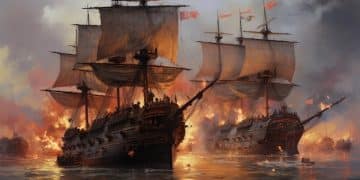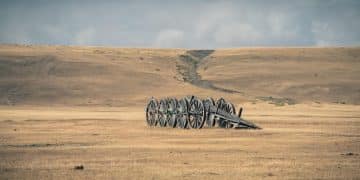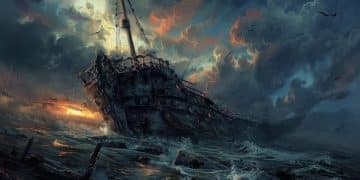Punic Wars: Rome vs. Carthage Military Strategies
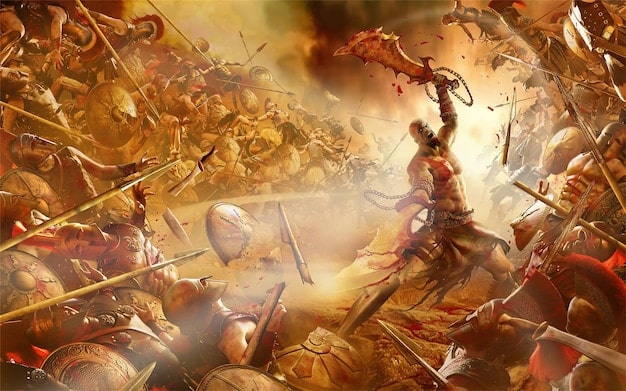
The Punic Wars, a series of conflicts between Rome and Carthage, showcased distinct military strategies; Rome excelled in land warfare with its disciplined legions, while Carthage depended on naval power and innovative tactics like using war elephants.
The **Punic Wars: Comparing the Military Strategies of Rome and Carthage** reveals a fascinating clash of civilizations, each with unique strengths and approaches to warfare that shaped the course of history. These wars were more than just battles; they were tests of resilience, innovation, and strategic thinking.
The Genesis of Conflict: Rome and Carthage
The stage for the Punic Wars was set by the rising ambitions of two great powers. Rome, expanding its influence throughout the Italian Peninsula, and Carthage, a powerful maritime empire dominating the Mediterranean, were destined for a collision. Their differing spheres of influence and economic interests created an environment ripe for conflict.
Both civilizations had different approaches to expansion and governance, which fueled their rivalry. Rome’s focus was on land-based conquest and assimilation, while Carthage prioritized trade and naval dominance. This divergence would profoundly influence their military strategies during the wars.
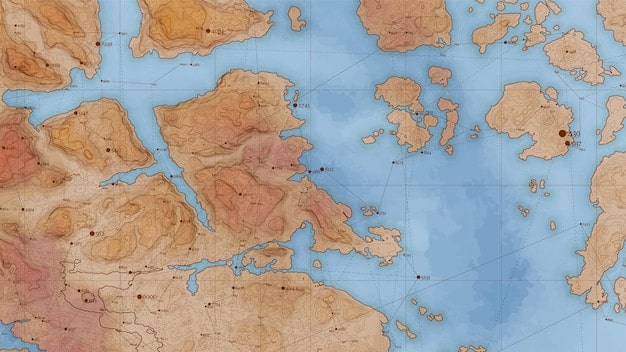
Economic and Political Rivalry
The rivalry between Rome and Carthage was deeply rooted in economic and political competition. Both powers sought to control key trade routes and resources in the Mediterranean, leading to inevitable clashes of interest. Sicily, a strategically important island, became a major point of contention.
Carthage’s control of maritime trade routes threatened Rome’s expanding economic interests, while Rome’s growing territorial ambitions challenged Carthage’s dominance in the region. These factors combined to create a volatile situation that ultimately led to war.
- Trade Dominance: Carthage’s extensive trade network posed a challenge to Rome’s economic growth.
- Strategic Locations: Control over key islands like Sicily and Sardinia was crucial for both powers.
- Political Influence: The expansion of Roman and Carthaginian influence led to direct competition and conflict.
In conclusion, the genesis of the Punic Wars was a complex interplay of economic and political factors. The rivalry between Rome and Carthage, driven by competing ambitions and interests, made conflict inevitable.
Roman Military Strategy: Legionary Prowess
Rome’s military strategy was centered around its highly disciplined and adaptable legions. These legions were the backbone of the Roman army, renowned for their organization, training, and effectiveness in land warfare. The Roman military machine was a force to be reckoned with, constantly evolving and adapting to new challenges.
The Roman army’s strength lay in its ability to maintain cohesion and discipline in the face of adversity. Roman soldiers were well-equipped, well-trained, and highly motivated, making them a formidable fighting force on the battlefield.
Legionary Structure and Tactics
The structure of the Roman legion was meticulously organized, allowing for flexibility and efficiency on the battlefield. Legions were divided into cohorts, maniples, and centuries, each with its own command structure. This hierarchical organization enabled Roman commanders to effectively control and maneuver large numbers of troops.
Roman tactics emphasized discipline, coordination, and the use of standardized formations. The legion’s ability to adapt to different terrains and enemy strategies was a key factor in its success. The Roman army’s training regime was rigorous, instilling a strong sense of duty and teamwork in its soldiers.
- Maniple System: A flexible battle line organization.
- Pilum and Gladius: Effective weaponry for close-quarters combat.
- Fortification Skills: The ability to construct fortified camps quickly.
In summary, the Roman military strategy was characterized by its legionary prowess. The strength and effectiveness of the Roman legions were crucial in Rome’s victories during the Punic Wars.
Carthaginian Military Strategy: Naval Supremacy and Mercenaries
Carthage’s military strategy relied heavily on its powerful navy and the use of mercenaries. As a maritime empire, Carthage controlled vital sea lanes and relied on its naval strength to project power and protect its trade interests. The Carthaginian navy was one of the most formidable in the ancient world.
Carthage also employed mercenary armies, drawing soldiers from various regions across the Mediterranean. While this provided a diverse range of skills and experiences, it also presented challenges in terms of loyalty and cohesion.
Naval Warfare and Trade Control
Carthage’s naval supremacy allowed it to control key trade routes and maritime passages. The Carthaginian navy was equipped with advanced ships and skilled sailors, enabling it to dominate the seas. Naval power was essential for protecting Carthaginian trade and projecting influence throughout the Mediterranean.
Carthaginian naval tactics emphasized maneuverability, ramming, and boarding actions. Carthaginian admirals were adept at using the sea to their advantage, controlling the flow of supplies and disrupting enemy movements.
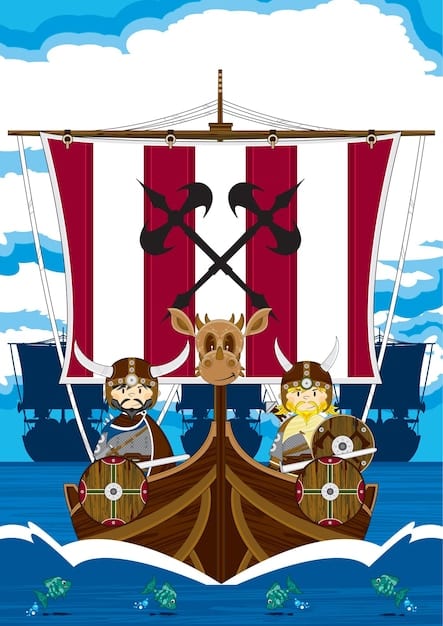
- Quinqueremes: Advanced warships that were the backbone of the Carthaginian navy.
- Trade Route Control: Protecting vital trade lanes was a key strategic objective.
- Naval Raids: Disrupting enemy shipping and coastal settlements.
In short, Carthaginian military strategy was characterized by its naval supremacy and reliance on mercenary armies. These elements allowed Carthage to maintain its dominance in the Mediterranean for centuries.
Key Battles and Strategic Decisions
The Punic Wars were marked by a series of key battles and strategic decisions that shaped the outcome of the conflict. From the early naval engagements of the First Punic War to the decisive land battles of the Second Punic War, each encounter tested the strengths and weaknesses of both sides.
Strategic decisions, such as Hannibal’s daring invasion of Italy and Scipio Africanus’s bold attack on Carthage, had profound consequences on the course of the war. These decisions reflected the strategic thinking of the commanders and the overall objectives of their respective states.
The Battle of Cannae: Hannibal’s Masterpiece
The Battle of Cannae in 216 BC is widely regarded as one of Hannibal’s greatest victories. By employing a double-envelopment tactic, Hannibal’s forces encircled and annihilated a much larger Roman army. The battle demonstrated Hannibal’s tactical brilliance and the effectiveness of the Carthaginian cavalry.
Cannae had a devastating impact on Rome, resulting in massive casualties and widespread panic. However, the Romans were able to recover and continue the war, demonstrating their resilience and determination.
The Battle of Zama: Scipio’s Triumph
The Battle of Zama in 202 BC marked the end of the Second Punic War and a decisive victory for Rome. Scipio Africanus, a brilliant Roman general, defeated Hannibal by employing innovative tactics and exploiting the weaknesses of the Carthaginian army. Zama secured Rome’s dominance in the Mediterranean and marked the decline of Carthage as a major power.
Scipio’s victory at Zama was a testament to his strategic acumen and the effectiveness of the Roman legions. The battle demonstrated the importance of adaptability and innovation in warfare.
- Cannae: Hannibal’s tactical masterpiece.
- Zama: Scipio’s decisive victory.
- Strategic Importance: Each battle had profound consequences on the war’s outcome.
In conclusion, the key battles and strategic decisions of the Punic Wars significantly influenced the outcome of the conflict. The battles showcased the strengths and weaknesses of both sides and demonstrated the importance of strategic thinking in warfare.
Logistics and Resources: Sustaining the War Effort
The Punic Wars placed immense demands on the logistical capabilities and resources of both Rome and Carthage. Sustaining the war effort required efficient supply chains, effective resource management, and the ability to maintain large armies and navies. The side that could best manage its resources had a significant advantage.
Rome and Carthage faced different challenges in terms of logistics and resources. Rome had a larger population base and greater agricultural capacity, while Carthage relied on its extensive trade network and access to mercenary soldiers. These differences influenced their respective strategies and capabilities.
Roman Resource Management
Rome’s ability to mobilize and manage its resources was a key factor in its eventual victory. The Roman state was highly organized, with efficient systems for taxation, procurement, and supply. Rome’s agricultural productivity and large population provided a strong foundation for its war effort.
The Roman army was adept at constructing roads, bridges, and fortifications, which facilitated the movement of troops and supplies. Roman engineers played a crucial role in maintaining the logistical infrastructure necessary for sustaining the war effort.
Carthaginian Supply Challenges
Carthage faced significant challenges in terms of logistics and resource management. Its reliance on mercenary armies meant that it had to maintain a steady flow of money and supplies to keep its soldiers loyal. Carthage’s trade network was vulnerable to disruption by Roman naval power.
The Second Punic War, in particular, strained Carthage’s resources, as Hannibal’s long campaign in Italy required constant reinforcements and supplies. The Carthaginian state struggled to meet these demands, which ultimately contributed to its defeat.
- Roman Organization: Highly efficient systems for resource management.
- Carthaginian Vulnerabilities: Reliance on trade and mercenary armies.
- Logistical Challenges: Sustaining long campaigns far from home.
In summary, the Punic Wars highlighted the importance of logistics and resources in sustaining a long-term war effort. Rome’s superior resource management and logistical capabilities gave it a significant advantage over Carthage.
Long-Term Impact and Legacy
The Punic Wars had a profound and lasting impact on both Rome and Carthage, as well as on the broader Mediterranean world. The wars reshaped the political landscape, altered trade patterns, and influenced the development of military strategies and political institutions. The legacy of the Punic Wars continues to resonate in historical studies and military analysis.
Rome emerged from the Punic Wars as the dominant power in the Mediterranean, paving the way for its expansion into a vast empire. Carthage was destroyed, its power broken forever. The wars had a transformative effect on Roman society, economy, and culture.
The Punic Wars also had a significant impact on the development of military tactics and strategies. The lessons learned from these conflicts influenced military thinking for centuries to come.
The Rise of Rome
The Punic Wars were a turning point in Roman history, marking the beginning of Rome’s transformation from a regional power into a global empire. Rome’s victories in the Punic Wars established its dominance in the Mediterranean and opened the door for further expansion into Europe, North Africa, and the Middle East.
The Punic Wars also had a profound impact on Roman society. The influx of wealth and slaves from conquered territories led to social and economic changes that reshaped Roman culture. The wars also fostered a sense of national identity and military prowess among the Roman people.
The Fall of Carthage
The Punic Wars led to the complete destruction of Carthage and the end of its role as a major power. Carthage’s defeat had a devastating impact on its economy, society, and culture. The city was razed to the ground, and its territories were annexed by Rome.
The fall of Carthage marked the end of a great civilization that had played a significant role in shaping the history of the Mediterranean. The legacy of Carthage, however, lived on in the form of its cultural and economic influence, as well as in the memories of its struggles against Rome.
| Key Point | Brief Description |
|---|---|
| ⚔️ Roman Legions | Disciplined and adaptable infantry formed the backbone of Rome’s military strategy. |
| 🚢 Carthaginian Navy | Naval supremacy ensured trade control and projected Carthaginian power across the Mediterranean. |
| 🐘 Hannibal’s Tactics | Innovative strategies, like at Cannae, challenged Roman dominance using diverse forces. |
| 🌍 Long-Term Impact | Rome’s victory reshaped the Mediterranean, leading to its imperial dominance and the end of Carthaginian power. |
Frequently Asked Questions
▼
The primary causes included economic competition, territorial disputes, and political rivalry between Rome and Carthage. Control over key regions like Sicily was a major point of contention.
▼
Rome relied on highly disciplined legions and land-based warfare, while Carthage emphasized naval power and the use of mercenary armies drawn from various regions.
▼
Key battles include Cannae, a tactical masterpiece for Hannibal, and Zama, where Scipio Africanus decisively defeated Hannibal and secured Rome’s victory in the Second Punic War.
▼
Carthage struggled with maintaining a steady flow of money and supplies for its mercenary armies. Its trade network was vulnerable to disruption by Rome’s naval power.
▼
The Punic Wars transformed Rome from a regional power into the dominant force in the Mediterranean, paving the way for its expansion into a vast empire across Europe and beyond.
Conclusion
In conclusion, the Punic Wars represent a pivotal period in ancient history, highlighting the clash of two great civilizations and their respective military strategies. Rome’s eventual triumph reshaped the Mediterranean world, leaving a lasting legacy that continues to intrigue and inform our understanding of military history.
